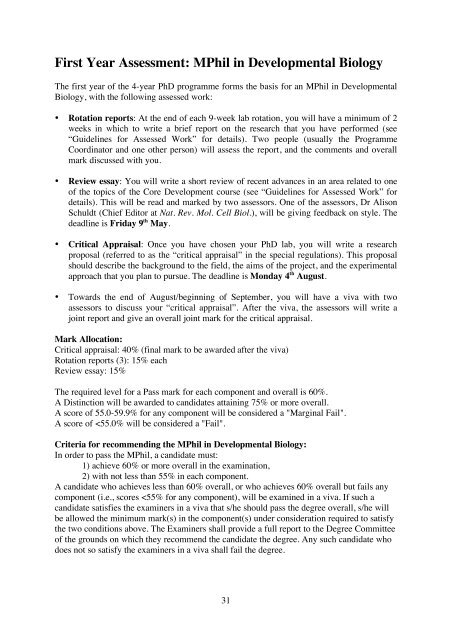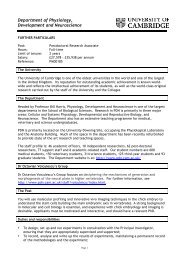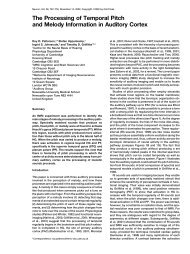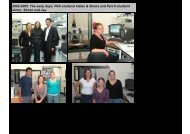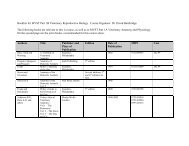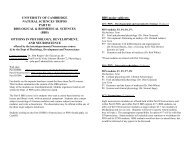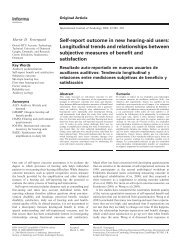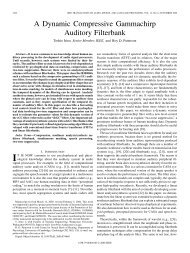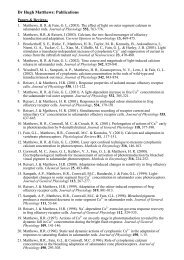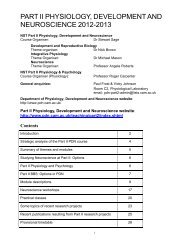Assessment guidelines (pdf)
Assessment guidelines (pdf)
Assessment guidelines (pdf)
You also want an ePaper? Increase the reach of your titles
YUMPU automatically turns print PDFs into web optimized ePapers that Google loves.
First Year <strong>Assessment</strong>: MPhil in Developmental Biology<br />
The first year of the 4-year PhD programme forms the basis for an MPhil in Developmental<br />
Biology, with the following assessed work:<br />
• Rotation reports: At the end of each 9-week lab rotation, you will have a minimum of 2<br />
weeks in which to write a brief report on the research that you have performed (see<br />
“Guidelines for Assessed Work” for details). Two people (usually the Programme<br />
Coordinator and one other person) will assess the report, and the comments and overall<br />
mark discussed with you.<br />
• Review essay: You will write a short review of recent advances in an area related to one<br />
of the topics of the Core Development course (see “Guidelines for Assessed Work” for<br />
details). This will be read and marked by two assessors. One of the assessors, Dr Alison<br />
Schuldt (Chief Editor at Nat. Rev. Mol. Cell Biol.), will be giving feedback on style. The<br />
deadline is Friday 9 th May.<br />
• Critical Appraisal: Once you have chosen your PhD lab, you will write a research<br />
proposal (referred to as the “critical appraisal” in the special regulations). This proposal<br />
should describe the background to the field, the aims of the project, and the experimental<br />
approach that you plan to pursue. The deadline is Monday 4 th August.<br />
• Towards the end of August/beginning of September, you will have a viva with two<br />
assessors to discuss your “critical appraisal”. After the viva, the assessors will write a<br />
joint report and give an overall joint mark for the critical appraisal.<br />
Mark Allocation:<br />
Critical appraisal: 40% (final mark to be awarded after the viva)<br />
Rotation reports (3): 15% each<br />
Review essay: 15%<br />
The required level for a Pass mark for each component and overall is 60%.<br />
A Distinction will be awarded to candidates attaining 75% or more overall.<br />
A score of 55.0-59.9% for any component will be considered a "Marginal Fail".<br />
A score of
Subsequent monitoring<br />
Year 2<br />
Towards the middle of Year 2 (March/April), i.e., your first PhD year, you will present a<br />
seminar during the morning session of the Wellcome 4-year Annual Symposium. This<br />
informal event is attended by all 4-year PhD students, the Programme Directors and the<br />
Programme Coordinator: it is an opportunity for you to present, in an informal setting, your<br />
PhD work so far and your plans for the future. (Year 4 students will present seminars in the<br />
afternoon session.) Note: this year’s Symposium will be on Friday 23 rd May.<br />
In June/July of Year 2 (the exact timing depends on your host department), you will be asked<br />
to write a First Year Report for assessment by the procedures appropriate for your host PhD<br />
department. This report and the assessors’ comments will be passed to the Management<br />
Committee.<br />
Year 3<br />
At the beginning of Year 3 (late October/November), i.e., the start of your second PhD year,<br />
you will give a seminar to the Management Committee, all Year 3 supervisors and the other<br />
Year 3 students. The Management Committee will meet after the seminars and discuss the<br />
progress of each student and the viability of each project. The Committee will then decide<br />
whether any action needs to be taken. Students or supervisors who have themselves identified<br />
problems should approach the Committee pro-actively.<br />
Note: during Year 3, and certainly by the end of Year 3, you should begin to consider<br />
directions for your post-doctoral career. For example, to join a lab in the United States, it is<br />
often necessary to apply a year in advance of your intended start date.<br />
Year 4<br />
At the beginning of Year 4 (October), i.e., the start of your third PhD year, you will be asked<br />
to write a short progress report with a strategy plan for the final year and a summary of the<br />
experiments that need to be completed before writing up. This will be discussed with your<br />
supervisor, who will give feedback and guidance for the completion of the work.<br />
Towards the middle of Year 4 (April/May), you will present a seminar in the afternoon<br />
session of the informal Wellcome 4-year Annual Symposium.<br />
The procedures for submission of PhD thesis and appointment of examiners will follow those<br />
at present operating in the University, as required by the Degree Committee.<br />
32
Guidelines for assessed work<br />
You MUST read the Faculty Board of Biology Statement on Plagiarism (copied below).<br />
This applies to ALL your written work.<br />
FACULTY BOARD OF BIOLOGY PLAGIARISM STATEMENT FOR STUDENTS<br />
http://www.bio.cam.ac.uk/sbs/facbiol/plagiarism.html<br />
In general, plagiarism can be defined as:<br />
The unacknowledged use of the work of others as if this were your own original work.<br />
In the context of an examination, this amounts to:<br />
Passing off the work of others as your own to gain unfair advantage.<br />
Such use of unfair means will not be tolerated by the University; if detected, the penalty may<br />
be severe and may lead to disciplinary proceedings being taken against you.<br />
1. The scope of plagiarism<br />
Plagiarism is defined as submitting as one's own work, irrespective of intent to deceive, that<br />
which derives in part or in its entirety from the work of others without due acknowledgement.<br />
It is both poor scholarship and a breach of academic integrity.<br />
Examples of plagiarism include copying (using another person’s language and/or ideas as if<br />
they are a candidate’s own), by:<br />
* quoting verbatim another person’s work without due acknowledgement of the source;<br />
* paraphrasing another person’s work by changing some of the words, or the order of the<br />
words, without due acknowledgement of the source;<br />
* using ideas taken from someone else without reference to the originator;<br />
* cutting and pasting from the Internet to make a pastiche of online sources;<br />
* submitting someone else’s work as part of a candidate’s own without identifying<br />
clearly who did the work. For example, buying or commissioning work via professional<br />
agencies such as ‘essay banks’ or ‘paper mills’, or not attributing research contributed by<br />
others to a joint project.<br />
Plagiarism might also arise from colluding with another person, including another candidate,<br />
other than as permitted for joint project work (i.e. where collaboration is concealed or has<br />
been forbidden). A candidate should include a general acknowledgement where he or she has<br />
received substantial help, for example with the language and style of a piece of written work.<br />
Plagiarism can occur in respect to all types of sources and media:<br />
* text, illustrations, musical quotations, mathematical derivations, computer code, etc;<br />
* material downloaded from websites or drawn from manuscripts or other media;<br />
* published and unpublished material, including lecture handouts and other students’ work.<br />
Acceptable means of acknowledging the work of others (by referencing, in footnotes, or<br />
otherwise) vary according to the subject matter and mode of assessment. Faculties or<br />
Departments should issue written guidance on the relevant scholarly conventions for<br />
submitted work, and also make it clear to candidates what level of acknowledgement might<br />
be expected in written examinations. Candidates are required to familiarize themselves with<br />
33
this guidance, to follow it in all work submitted for assessment, and may be required to sign a<br />
declaration to that effect. If a candidate has any outstanding queries, clarification should be<br />
sought from her or his Director of Studies, Course Director or Supervisor as appropriate.<br />
Failure to conform to the expected standards of scholarship (e.g. by not referencing sources)<br />
in examinations may affect the mark given to the candidate's work. In addition, suspected<br />
cases of the use of unfair means (of which plagiarism is one form) will be investigated and<br />
may be brought to one of the University's Courts. The Courts have wide powers to discipline<br />
those found guilty of using unfair means in an examination, including depriving such persons<br />
of membership of the University, and deprivation of a degree.<br />
2. How to avoid plagiarism<br />
The stylistic conventions for different subjects vary and you should consult your Course<br />
Organiser or project supervisor about the conventions pertaining in your particular subject<br />
area. Most courses will issue written guidance on the relevant scholarly conventions and you<br />
are expected to have read and to follow this advice. However, the main points that apply to<br />
submitted work (e.g. dissertations, project reports) are:<br />
* when presenting the views and work of others, include in the text an indication of the<br />
source of the material, e.g. 'as Sharpe (1993) has shown,' and give the full details of the work<br />
quoted in your bibliography;<br />
* if you quote text verbatim, place the sentence in inverted commas and give the<br />
appropriate reference, e.g. 'The elk is of necessity less graceful than the gazelle' (Thompson,<br />
1942, p 46) and give the full details in your bibliography as above;<br />
* if you wish to set out the work of another at length so that you can produce a counterargument,<br />
set the quoted text apart from your own text (eg by indenting a paragraph) and<br />
identify it by using inverted commas and adding a reference as above. NB long quotations<br />
may infringe copyright, which exists for the life of the author plus 70 years.<br />
* if you are copying text, keep a note of the author and the reference as you go along, with<br />
the copied text, so that you will not mistakenly think the material to be your own work when<br />
you come back to it in a few weeks' time;<br />
* if you reproduce an illustration or include someone else's data in a graph include the<br />
reference to the original work in the legend, eg (figure redrawn from Webb, 1976) or<br />
(triangles = data from Webb, 1976);<br />
* if you wish to collaborate with another person on your project, you should check with<br />
the Course Organiser to see whether this might be allowed and then seek their permission;<br />
* if you have been authorised to work together with another candidate or other<br />
researchers, you must acknowledge their contribution fully in your introductory section. If<br />
there is likely to be any doubt as to who contributed which parts of the work, you should<br />
make this clear in the text wherever necessary, e.g. 'I am grateful to A. Smith for analysing<br />
the sodium content of these samples';<br />
* be especially careful if cutting and pasting work from electronic media; do not fail to<br />
attribute the work to its source. If authorship of the electronic source is not given, ask<br />
yourself whether it is worth copying.<br />
3. The Golden Rule:<br />
The examiners must be in no doubt as to which parts of your work are your own<br />
original work and which are the rightful property of someone else.<br />
34
Rotation Report Guidelines<br />
The rotation reports have a strict word limit of 7000 words, including Figure Legends but<br />
excluding the bibliography (and words in Tables). We suggest that you break the report down<br />
into Summary, Introduction, Methods, Results, and Discussion. Remember, though, that this<br />
is a report of what you did in your rotation, not a paper for publication, and that it should be<br />
accessible to a non-specialist.<br />
Your word count (excluding the bibliography) must be given on the title page.<br />
Citations in the text should not be numbered, but cited as: “Alpha and Beta, 1998; Gamma et<br />
al., 2005; Delta, 2008”, etc. (You are advised to use a referencing program like EndNote,<br />
Papers, or Bookends for this.)<br />
Some tips: The Introduction should give the non-specialist reader all the background<br />
information necessary to understand your project and set the results in context. The Methods<br />
section should be concise, yet contain sufficient information to allow someone else to repeat<br />
the work: give priority to novel approaches, and condense standard molecular methods by<br />
citing previous publications, manufacturer’s instructions, etc. The Results section should<br />
flow as a logical, coherent description of the project, including the rationale for doing each<br />
experiment. Make sure you put each Figure legend together with the appropriate Figure, just<br />
as in a paper; if you can’t fit the legend and figure on the same page, you could always put<br />
the legend on the facing page. Remember that this is a report of what you did in your<br />
rotation, not a paper for publication: don’t just put in your best (or only positive) results, but<br />
discuss problems encountered, troubleshooting etc. The Discussion should place the results<br />
in context in the literature and include suggestions for further experiments.<br />
Please get into the habit of always using a spell-checker as you write, adding in technical<br />
terms as you go along so the spell-checker recognises these as well. If you are a non-native<br />
English speaker, it can be useful to ask a native speaker (who does not have to be a scientist)<br />
to read the report through for mistakes in English usage/grammar, before submitting the final<br />
version. Any assistance should of course be acknowledged in an Acknowledgements section.<br />
Figures may be printed out by AVMG (PDN, Anatomy Building basement; funding code<br />
PMKS) if you do not have easy access to a colour printer. It is simplest to prepare figures in<br />
Photoshop, Illustrator, Freehand or Powerpoint. AVMG will bind the report (code PMKS).<br />
You should produce THREE bound copies of the report and a <strong>pdf</strong> version. One bound copy<br />
should be given to your rotation supervisor. The other two bound copies (one of which you<br />
will get back after assessment) and the <strong>pdf</strong> copy should be submitted to the PDN Graduate<br />
Secretary, Aileen Briggs, by:<br />
Rotation 1: Friday 10 th January<br />
Rotation 2: Friday 4 h April<br />
Rotation 3: Friday 4 th July<br />
The reports will be assessed by two assessors, one of whom is usually the Programme<br />
Coordinator. Please take on board the comments you receive from your assessors when<br />
writing subsequent reports.<br />
35
Review Essay Guidelines<br />
For your review, you may choose any of the questions discussed in the Core Course: we<br />
suggest you confer with the session leader and the Programme Coordinator to check your title<br />
is appropriate. We would prefer it not to be too close to your rotation projects.<br />
We suggest you follow the <strong>guidelines</strong> for Progress articles in Nature Reviews Molecular Cell<br />
Biology. These focus on one topical aspect of a field in which strong advances are being<br />
made, rather than providing a comprehensive literature survey. This article format is short<br />
(
Critical Appraisal (Research Proposal) Guidelines<br />
Note: You should inform the Programme Coordinator of your preferred choice of PhD lab<br />
and provisional critical appraisal title by 12pm on Monday 23 rd June.<br />
1. The maximum number of words, excluding bibliography, is 8000. This is an upper<br />
limit: you do not have to use the maximum! You must put the final word count (excluding<br />
bibliography) on the cover page. Citations in the text should not be numbered, but cited as:<br />
“Alpha and Beta, 1998; Gamma et al., 2005; Delta, 2008”, etc.<br />
2. You must include in the bound report a Preface with a signed statement along the<br />
following lines: "I confirm that the material in this Critical Appraisal is not copied from any<br />
published material, nor is it a paraphrase or abstract of any published material unless it is<br />
identified as such and a full source reference is given. I confirm that, other than where<br />
indicated as above, this document is my own work."<br />
3. The organisation should be:<br />
(i) Aims of the project<br />
This should be succinct, with perhaps a few sentences of overview explaining the general<br />
focus and then listing some specific objectives/goals.<br />
(ii) Background and work that has led up to the project.<br />
This should set the scene for the research, so needs to be a summary of the relevant literature,<br />
perhaps beginning more broadly and getting more specific. It may include some preliminary<br />
unpublished data from your work or from other work in the lab if it is relevant. It may also<br />
include some diagrams or pictures of data if they are helpful. We suggest that about 1/3 of the<br />
proposal might be background, but there is no set rule.<br />
(iii) Experimental design and methods to be used in investigating this problem.<br />
This should describe your plan of investigation. It is often helpful to subdivide this into<br />
sections. These might represent sequential steps in the investigation (e.g. genetic screen;<br />
molecular characterisation of genes; etc.) or parallel approaches (e.g. loss of function studies;<br />
gain of function studies; etc.) or different questions to be addressed (e.g. Does X regulate Y?<br />
Is X essential for mesoderm development? etc). See what works best for your proposed work.<br />
Remember to think about issues like:<br />
- If you will be doing a screen and then characterising some of the genes isolated, how<br />
will you choose which ones to characterise?<br />
- Will you be able to distinguish control from experimental animals? How?<br />
- **What controls will you use to test whether your results are meaningful?**<br />
- Do you foresee any pitfalls? If so, how might you circumvent them if they arise?<br />
- What are your back-up plans in case this project fails to work out as expected?<br />
Please include a time-line, or flow diagram, to show you have a realistic idea of how long<br />
each part of the project is likely to take.<br />
(iv) Budget.<br />
This should be an appendix (and does not count towards the word limit). Don't feel the need<br />
to go into too much detail here, but think about where the major costs of your project will lie.<br />
Subdivide the budget into: animals and animal costs (be it worms or mice etc.), consumables<br />
(e.g. enzymes; molecular biology kits; antibodies; tissue culture reagents; tips, tubes and<br />
37
other plastics; check out the basic costs of some of these and consider where the bulk of your<br />
costs are going to lie, perhaps list a few major categories), equipment (if you need any<br />
specific equipment; if not there may not be anything in this category). You should try to find<br />
as much of this financial information out for yourself as possible, rather than relying on your<br />
supervisor (they will not be at all happy to have you ask them about it!!). You should have<br />
access to catalogues and the web, so do some research. The aim is to increase your awareness<br />
of the costs of different kinds of experiments.<br />
Note: It is **very** important to get feedback from your supervisor on at least one draft of<br />
the critical appraisal. Please allow yourself enough time for discussions with your<br />
supervisor and to get their feedback, and check on your supervisor’s availability – s/he<br />
may be away for part of the writing period, so you need to take this into consideration in your<br />
planning.<br />
THREE bound copies of the proposal, together with the “Certificate of Submission” form<br />
(http://www.gradschl.lifesci.cam.ac.uk/Current%20Students/Lifecycles/SubmissionOfDissert<br />
ationForm.rtf/view) and a <strong>pdf</strong> version of the proposal, should be submitted to Aileen Briggs<br />
by 3pm on Monday 4 th August. Please note that this is a University deadline: there is no<br />
possibility of extension.<br />
38


